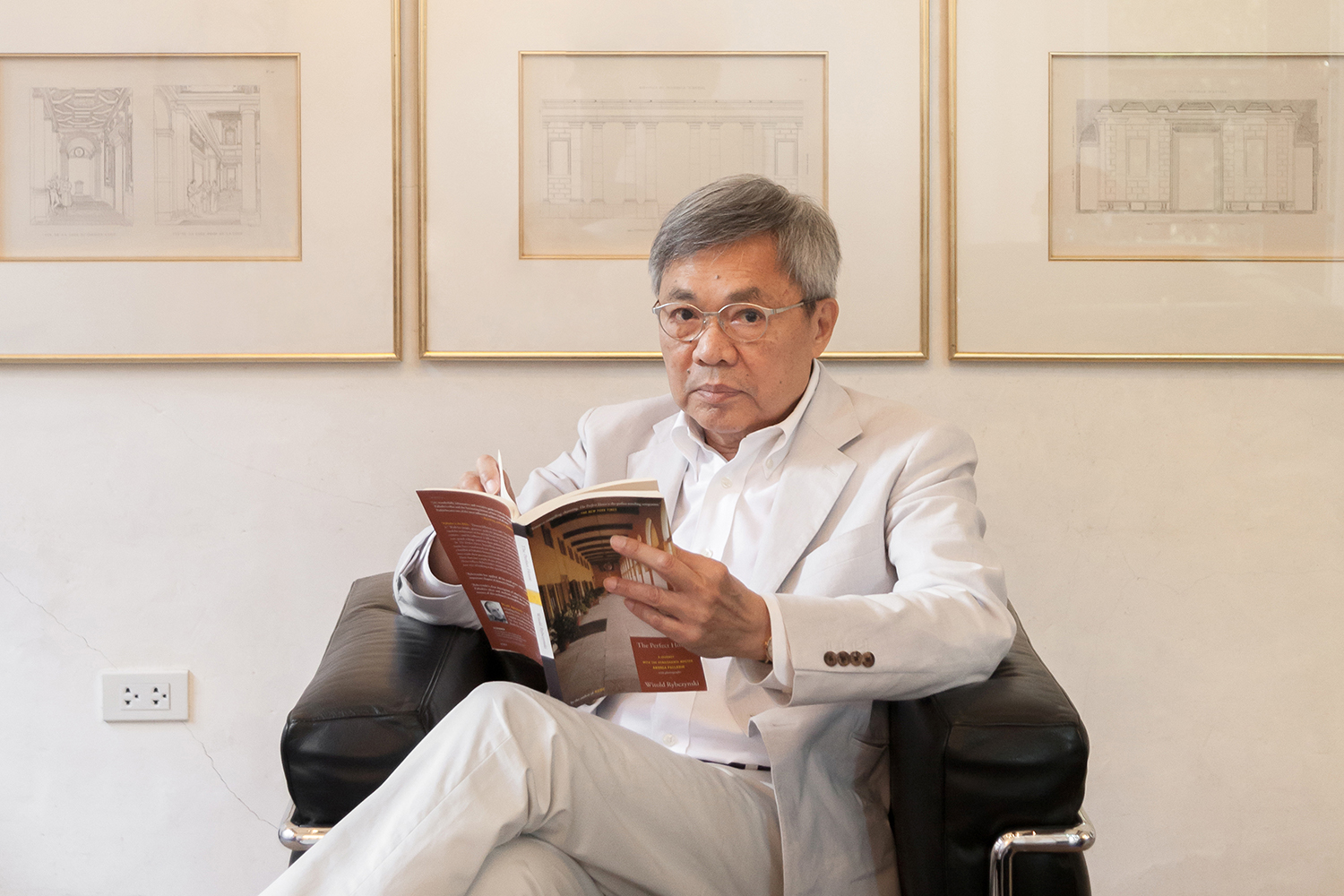AT THE AGE OF 75, THE THAI TRADITIONALIST ARCHITECT ONG-ARD SATRABHANDHU REFLECTS UPON HIS VIEWS TOWARDS THE PAST AND THE IMPORTANCE OF HISTORY
INTERVIEW: PAPHOP KERDSUP / WICHIT HORYINGSAWAD
PORTRAIT: KETSIREE WONGWAN
PHOTO COURTESY OF ONG-ARD ARCHITECTS
art4d: อยากให้ช่วยย้อนกลับไปสักหน่อย ว่าทำไมตอนนั้นถึงเลือกเรียนสถาปัตยกรรม
Ong-ard Satrabhandhu: ช่วงนั้นที่บ้านผมกำลังสร้างบ้าน แล้วผมเองก็ชอบไปป้วนเปี้ยนตอนก่อสร้าง คุณพ่อก็คิดว่าผมสนใจ ซึ่งผมเองก็ว่าคุณพ่อคิดถูกที่ให้ผมไปเรียนสถาปัตยกรรม แล้วก็เป็นโชคอย่างหนึ่งด้วยที่ Cornell (Cornell University College of Architecture, Art, and Planning) เขารับผม คนไทยรุ่นก่อนหน้าผมหนึ่งปีก็มีคุณแดน (แดน วงศ์ประศาธน์) คือตอนนั้นคณะสถาปัตย์มีกันแค่ 2 คน ตอนเริ่มปี 1 ผมไม่รู้เรื่องอะไรทั้งสิ้นเลย ไม่มีพื้นฐาน นักเรียนที่จะมาเรียนสถาปัตย์ตอนอยู่มัธยมเขาก็ได้ศึกษาพื้นฐานกันบ้างแล้ว จะรู้จักงานของ architect ที่เป็น master builders สมัยนั้น ผมไม่รู้จักใครเลย ภาษาก็ไม่รู้ ที่ผ่านมาได้คือพอเข้าไปเรียนปุ๊บไปค้นคว้า เกิดสนใจ แล้วรู้สึกประทับใจ
art4d: ตอนนั้นที่ Cornell คุณเรียนกับใครบ้าง
OS: มีอาจารย์ชื่อ Colin Rowe เขาสอน History and Theory of Architecture ผมได้มีโอกาสเรียนด้วยตอนปี 3 งานของ Colin Rowe ที่ทุกคนมักอ้างถึงก็คือเรื่อง mathematics ของ ideal villa (The Mathematics of the Ideal Villa and Other Essays) Colin Rowe ทำให้ประวัติศาสตร์สถาปัตย์น่าสนใจเพราะเขาเอามาเปรียบเทียบกับปัจจุบัน เขาทำให้เราเห็นค่าของ history ทำให้เรารู้ว่าเราตัดขาดจาก history ไม่ได้ แต่ในขณะเดียวกันพวกเราก็ไม่รู้ว่าจะเอาสิ่งที่ Colin Rowe พูดมาใช้ยังไงกับงานออกแบบ ถึงแม้ว่าเขาจะดึงความเหมือนของงาน Palladio กับ Le Corbusier แต่ไม่มีใครสามารถนำมาปฏิบัติได้ สถาปัตยกรรมที่ดีจะต้องมีความชัดเจน เรียบง่าย สมดุล มีสัดส่วนที่กลมกลืน และดูสงบเงียบ ตอนไปเรียนต่อที่ Yale (Yale School of Architecture) ช่วงนั้นมี James Sterling เขากำลังมีชื่อเสียง เขามาสอนเราก็จะตื่นตัวมาก แต่ตอนนั้นผมไม่รู้ว่า Sterling ที่เราประทับใจงานเขานี่ เบื้องหลังเขามี Léon Krier ซึ่งก็คือคนเดียวกับที่เขียนคำนำให้กับหนังสือผม Sterling ก็ไม่ได้พูดถึง Krier แล้วมันเป็นการยากที่จะทำงานแบบ vernacular, traditional หรือ classical แต่ผมได้ยินคนพูดกันมาก โดยเฉพาะในประเทศสยามนี่นะ ว่าทำงานพวกนี้มันไม่ได้ใช้ความคิดสร้างสรรค์ ไปลอกเขามา ง่ายจะตาย แต่ความจริงไม่ ที่พูดกันเช่นนั้นเพราะไม่เคยลองทำงานที่เป็น traditional tropical architecture ถ้าลองทำจะรู้ว่าถ้าไม่มีความรู้และเข้าใจภาษาของงาน traditional และ classical ก็เหมือนคนพูดผิดไวยากรณ์
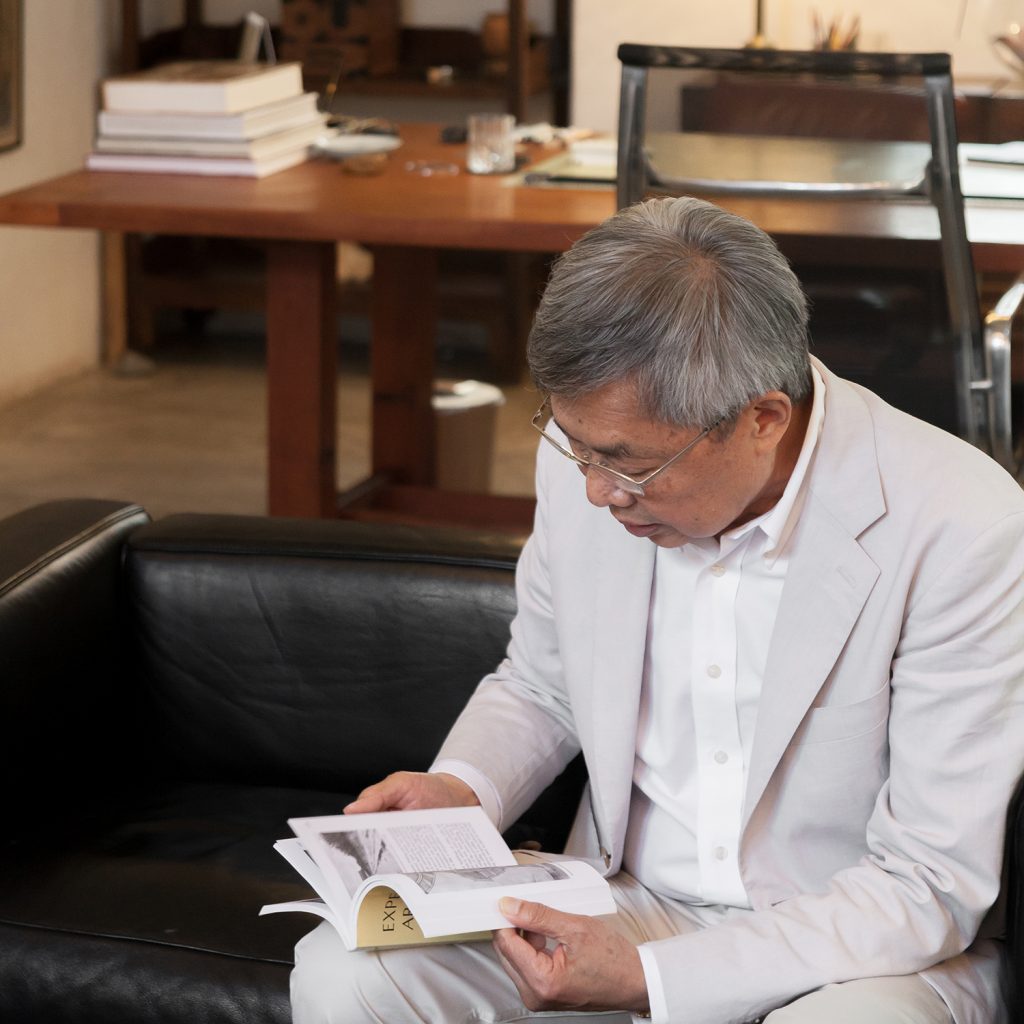
art4d: นอกจาก Colin Rowe, James Sterling และ Léon Krier มีสถาปนิกคนไหนที่มีอิทธิพลกับวิธีการมองสถาปัตยกรรมของคุณอีกบ้าง
OS: ช่วงที่ผมเรียนมี Le Corbusier แน่นอนเขาคือ master builder และมี Alvar Aalto, Frank Lloyd Wright ผมยังเข้าไปไม่ถึง Mies van der Rohe แต่ประทับใจความประณีตและความเรียบของงานเขา
art4d: คุณทำวิทยานิพนธ์เรื่องอะไรตอนเรียนที่ Cornell
OS: ทำวางผังโรงเรียนปานะพันธุ์ เน้นการออกแบบพื้นที่ว่าง (space)
art4d: หลังจากเรียนจบจากที่ Yale แล้วจากนั้นก็กลับมาไทยแล้วเปิดออฟฟิศเลยหรือเปล่า
OS: พอเรียนจบ ผมทำงานที่อเมริกาอยู่เกือบ 2 ปี อยู่ที่ New Haven พักหนึ่ง แล้วช่วงหลังมาอยู่ Bloomfield Hills ทำที่ Glen Paulsen (Glen Paulsen & Associates Architects) ตอนไปสัมภาษณ์งานผมก็บอกเขาว่าผมไม่ถนัดเขียนแบบ เขาเลยให้ผมเป็นคนออกแบบ สุดท้ายก็มีงานอยู่ที่นั่นนิดหน่อย ผมก็พอใจที่จะอยู่ที่นั่นนะ แต่คุณแม่ผมเก่ง มาบอกว่ามีงานให้ผม 2 ชิ้น ที่โรงเรียนปานะพันธุ์ชิ้นหนึ่ง แล้วก็ที่มหาวิทยาลัยเกษตรศาสตร์อีกชิ้น ผมก็เลยกลับ ไม่งั้นผมก็คงจะอยู่ไปเรื่อยๆ
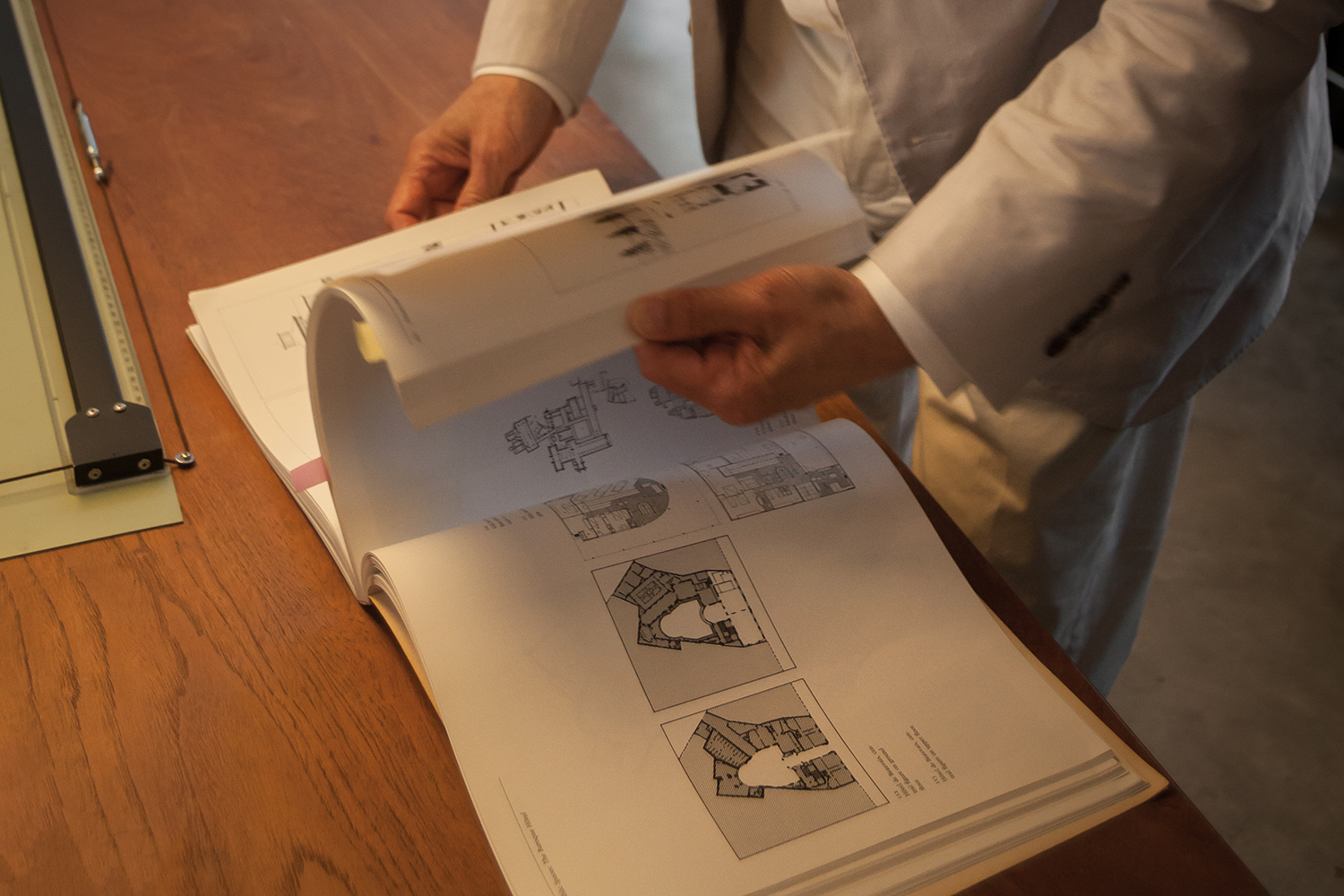
art4d: ทำไมตอนนั้นถึงตัดสินใจที่ให้งานทั้งสองชิ้นที่ว่าเป็นแนวทางแบบ Corbusian ในลักษณะนี้
OS: ผมเองไม่ค่อยมีความรู้ ก็คิดว่าคอนกรีตเปลือยนี่น่าจะเหมาะกับเมืองไทยมาก คนไทยมีฝีมือทำ formwork และค่าแรงถูก แล้วตึกไม่ต้องทาสีมันก็น่าจะดี บวกกับผมชอบงานของ Corbusier เพราะว่ามีรูปทรงที่ดึงดูด ไม่ได้คิดเลยว่าคนอยู่แล้วมันจะสบายหรือไม่ คนจะชอบไหม ไม่คิดหรอก เพราะตอนนั้นคิด abstract มาก คิดแบบเด็กๆ คงไม่ผิดอะไรกับเด็กสมัยนี้ ที่ได้ยินว่าเอาความน่าสนใจเป็นหลัก ทีนี้คอนกรีตมันเป็น mass มันเก็บความร้อน แล้วระบายออกให้คนที่อยู่ในอาคาร จึงไม่ใช่วัสดุที่เหมาะสม
art4d: แล้วพวกตัวสัดส่วนของโครงสร้างอาคารนี่คุณใช้ Le Modulor หรือหลักอะไรบ้างหรือเปล่า
OS: Le Modulor นี่ไม่ได้ใช้ แต่ผมพยายามหาสัดส่วนที่ดีโดยใช้ golden triangle หรือองค์ประกอบต่างๆ ที่ Colin Rowe สอนไว้ เช่น ทุกส่วนของตึกต้องมีความสอดคล้องกลมกลืนกัน ถ้าเราศึกษางานสถาปัตย์ที่ดีในประวัติศาสตร์จะพบว่ามีสัดส่วนที่งดงามเพราะยึดหลัก golden triangle และจัตุรัส Andrea Palladio ผู้ได้ชื่อว่าเป็น “บิดาแห่งสถาปัตยกรรมของอเมริกา” ได้เขียนหนังสือ The Four Books of Architecture พูดถึงภาษาของ Classical Architecture และความสำคัญของสัดส่วน
ที่ชอบงาน Corbusier เพราะมันประทับใจเรามาก ผมไปดูงานเขาเกือบทุกๆ ตึกเลยนะ ทั้งในยุโรป ที่ Chandigarh ก็ไปแล้ว ตอนเพิ่งเสร็จใหม่ๆ แต่เรามองกลุ่มอาคารทั้งหมดเป็นฟอร์มที่สวย movement เขาสวย เขาให้ความสำคัญกับ Architectural Promenade เป็นอย่างมาก
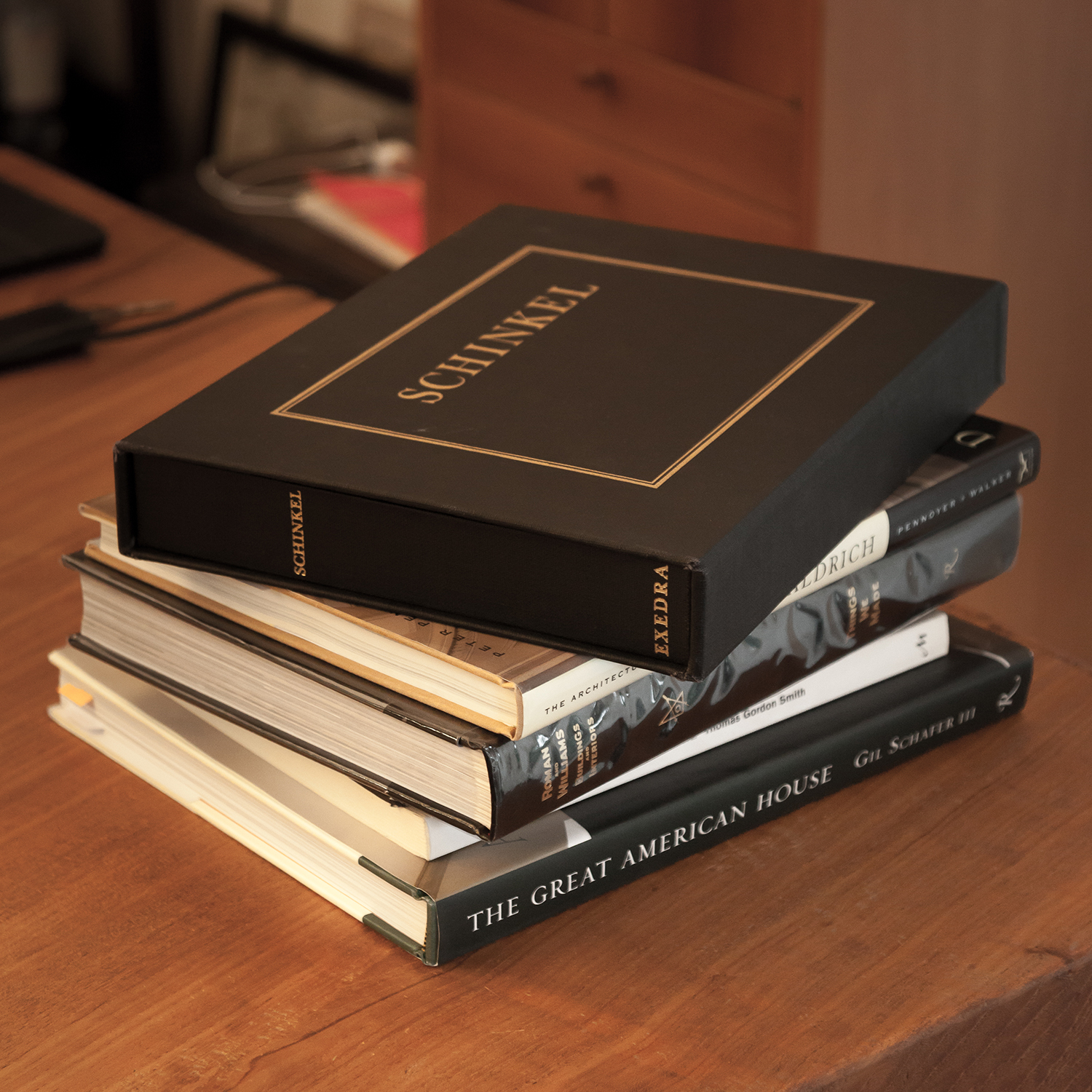
art4d: แสดงว่าหลักที่เป็นแกนของทุกๆ งานที่ทำมาตลอดตั้งแต่ต้นของคุณมันคือ “สัดส่วน” ใช่หรือเปล่า
OS: สิ่งที่สำคัญนอกเหนือจากสัดส่วนที่ผมคิดมาตลอด คือ movement through space อันนี้ของ Corbusier สถาปัตยกรรมจีนโบราณก็มี movement ที่สวยมากเลย จีนโบราณมีหลัก 4 ประการที่สำคัญคือ bilateral symmetry, axiality, hierarchy และ enclosure หลักทั้ง 4 ข้อนี้ ผมเห็นว่าเราควรนำมาใช้ Mies van der Rohe เขามีบ้านอยู่หลังหนึ่งที่เหมือนบ้านจีนเป๊ะเลยนะ เขาสนใจ philosophy จีนมาก เพื่อนเขาสอน philosophy จีนที่มหาวิทยาลัย เพราะฉะนั้นเราไม่ควรที่จะไม่ใช่แค่ให้ความสำคัญนะ แต่เราต้องรู้ประวัติศาสตร์สถาปัตยกรรมด้วย มันเป็นอะไรที่เราไม่รู้ไม่ได้
art4d: ประวัติศาสตร์สถาปัตยกรรมดูจะเป็นวิชายาขมที่นักเรียนสถาปัตย์ไม่ค่อยสนใจ ทั้งๆ ที่ความเป็นจริงแล้วมันมีความสำคัญกับการทำงานสถาปัตยกรรมเหมือนกัน สำหรับคุณประวัติศาสตร์มันสำคัญยังไง
OS: ผมว่าถ้าเราสอนประวัติศาสตร์สถาปัตยกรรมด้วยการหยิบ villa ที่สวยๆ มาสอน เด็กเขาก็คงจะสนใจนะ ไม่ต้องไปเน้นว่าสร้างปีอะไร ใครออกแบบ แต่ให้ไปเน้นว่าทำไมมันถึงงดงาม Villa Lante ที่ใกล้โรม เป็นงานออกแบบแบบ Mannerist ที่สวยงามมาก สวนกับตัว villa นั้นกลมกลืนกับพื้นที่ที่เป็นเนินเขา movement through space นั้นสวยงามมากๆ อธิบายลำบาก ต้องไปเห็นด้วยตาเอง แล้วจะประทับใจ ประการหนึ่งที่สถาปนิกปัจจุบันผิดกับสมัยโบราณคือความรู้ในการก่อสร้าง อย่างผมทำอะไรไม่เป็น จริงๆ เราต้องเลื่อยไม้เป็น ตอกตะปูเป็น แล้วจะมี feeling ที่ดี ที่ Yale ตอน Charles Moore เป็น dean เขาเริ่มให้เด็กร่วมทำโปรเจ็คต์กันแล้วก็ไปสร้างให้กับ community ซึ่งอันนี้มันดีมากๆ เลย สถาปนิกสมัยก่อนนี่ก็ไม่ได้เรียนสถาปัตย์เป็นเรื่องเป็นราวนะ Brunelleschi ทำโดมขึ้นมาก็ไม่ได้เป็นวิศวกร แต่เขาก็ต้องคิดว่าจะสร้างยังไง ซึ่งอย่างนั้นมันทำให้เราเข้าไปถึงแกนจริงๆ เมื่อผมเริ่มทำงานสมัยนั้นยังมีช่างที่เป็น craftman อยู่ผมจะถามเขาว่าผมมีความคิดอย่างนี้ แต่จะสร้างได้อย่างไร
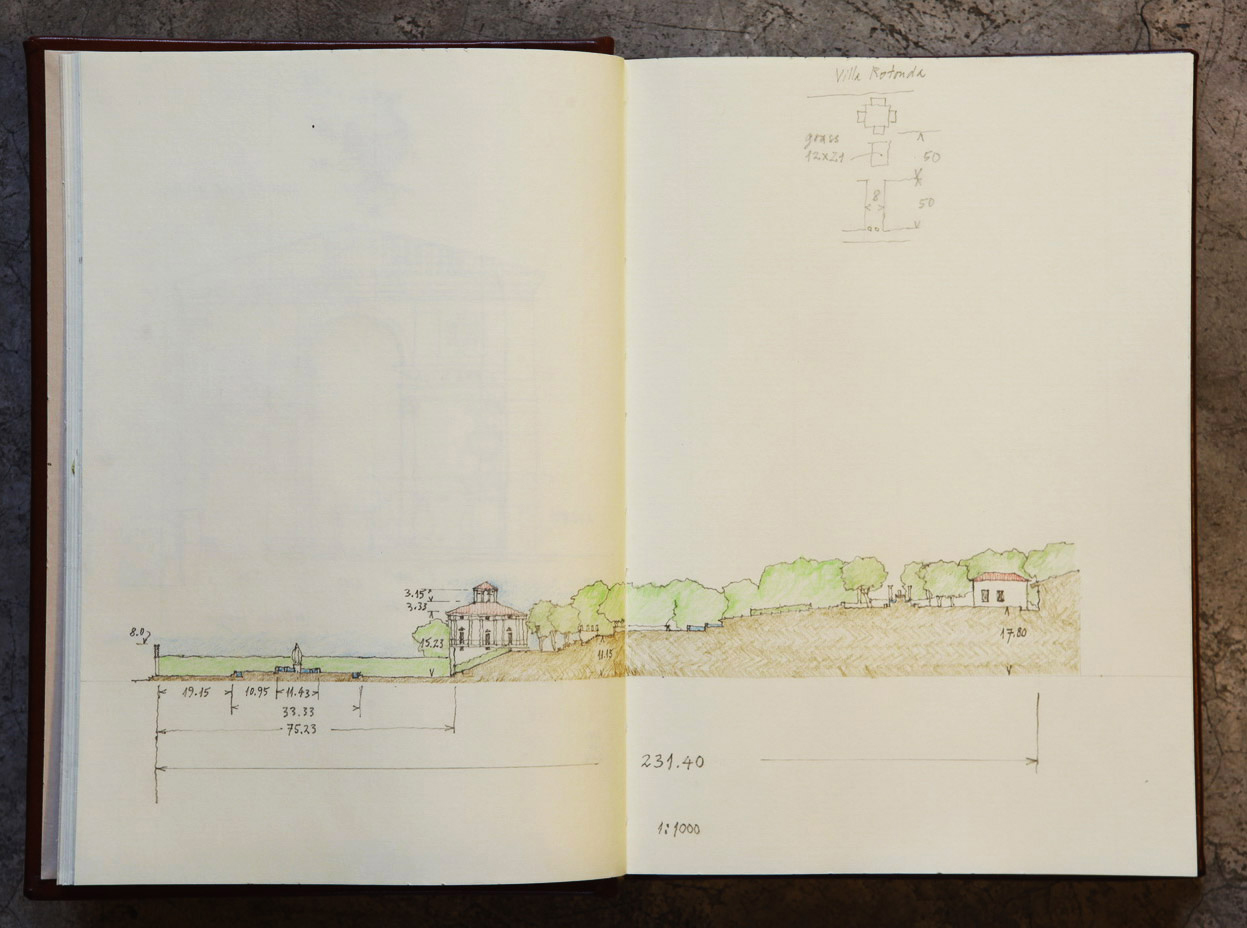
art4d: คุณภาพของผู้รับเหมาสมัยก่อนกับสมัยนี้ต่างกันมากหรือไม่
OS: ตอนนี้ไม่มีคุณภาพเลย สมัยก่อนยังพอมีช่างที่ผมปรึกษาได้ เดี๋ยวนี้ผมถาม เขาก็จะบอกว่าเอายังไง ให้เราบอกเขา ผมไม่รู้ถึงได้ถามไง มันน่าเศร้ามาก อย่างแต่ก่อนนี่ Palladio มาจากช่างแกะหิน แล้วก็มีคนเห็นแววเลยเอาเขาไปขัดเกลา แต่ตอนนี้คนที่ทำรับเหมาเขาทำเป็นแค่ธุรกิจ กลายเป็นนายทุน แล้วก็คอยหาคนโน้นมาทำงานอิฐ คนนี้มาทำงานไม้ อะไรต่างๆ มันกลายเป็นการทำงานแบบแค่ให้เสร็จๆ ไป ไม่ใช่เพื่อผลงาน อย่างช่างหรือผู้รับเหมาที่ผมรู้จักช่วงปี 70 ที่เขารับงานและทำงานด้วยกัน เขาจะมีความภูมิใจในผลงานมาก แต่ตอนนี้มันไม่มีแล้ว ผู้รับเหมาที่ผมประทับใจ เรียกว่าต้องเคารพ เขาชื่อคุณชุณห์ ชาตรูปเสวี เป็นผู้รับเหมาที่สามารถช่วยเหลือเรา ทำให้งานเราดีขึ้นได้ เขาก็เป็นคนสร้างที่ปานะพันธุ์ แล้วก็ที่มหาวิทยาลัยเกษตรศาสตร์ด้วย ถ้าผมทำงานอะไรผมก็จะบอกว่าเอาคนนี้ พอเขาเสียชีวิตไปผมก็ใช้ลูกเขาต่อจนตอนนี้ลูกเขาก็เลิกไปแล้ว เพราะว่าถ้าทำงานเพราะรักในผลงานจริงๆ มันไม่ค่อยทำเงินเท่าไหร่ ลูกเขาอีกคนนี่เปลี่ยนไปขายก๋วยเตี๋ยวนะ ไม่ใช่เรื่องตลก ขายก๋วยเตี๋ยวจริงๆ เขาบอกว่าเงินมันดีกว่า งานเบากว่าด้วย
art4d: แล้วอย่างเรื่องของวิศวกร สมัยก่อนคุณทำงานกับวิศวกรคนไหน
OS: แต่ก่อนเลย ทำกับอาจารย์อรุณ (ศาตราจารย์กิตติคุณ อรุณ ชัยเสรี) ตอนหลังนี้พอมาอยู่เชียงใหม่ก็เปลี่ยนมาเป็นสำนักงานทางเชียงใหม่แทน ขอพูดเรื่องผู้รับเหมาต่อ อย่างงานอาคารสำนักงานใหญ่ บริษัท โตชิบา นี้ทางบริษัทมีช่างก่ออิฐที่มีฝีมือมาก จึงทำให้งานสำเร็จออกมาตามแบบได้
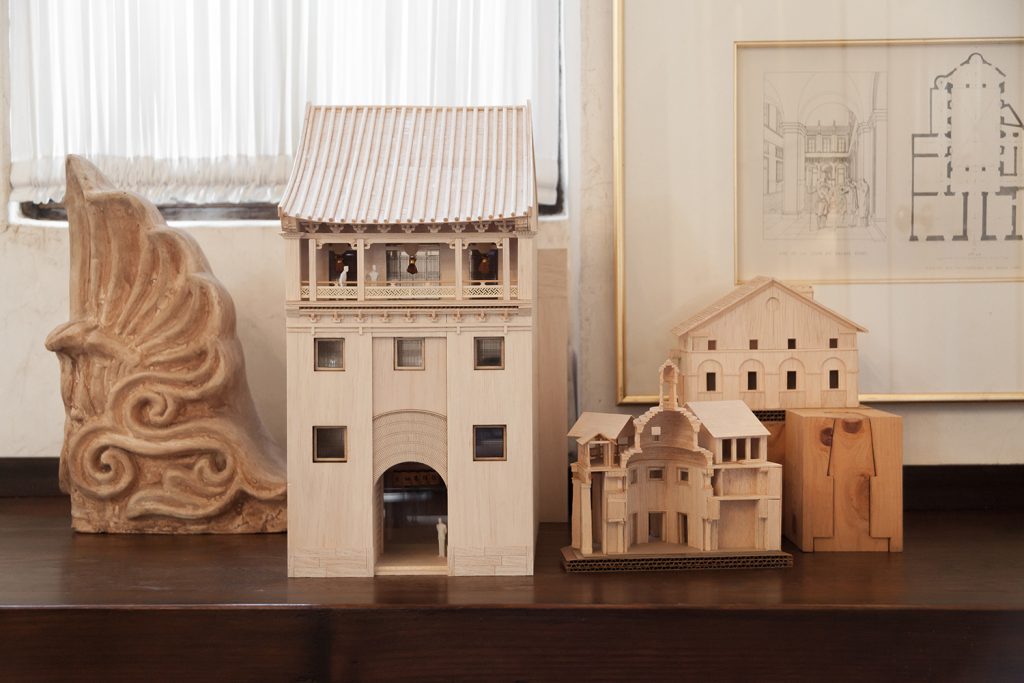
art4d: นอกจากผู้รับเหมาแล้ว คิดว่าความประณีตของสถาปนิกในตอนนี้กับสมัยก่อนมันต่างกันด้วยหรือไม่เพราะเหมือนทุกวันนี้ทุกคนดูจะแข่งกับเวลากันไปหมด
OS: ก็อาจจะมีบ้าง เพราะทางลูกค้าเองก็จะเร่งมากขึ้นด้วย คือมันมีหลายคนเลยที่ผมทำให้ไม่ได้เพราะเขาให้เวลาผมสั้น ผมก็พยายามบอกนะว่าจริงๆ ถ้าเวลาสั้นงานมันก็เสร็จเร็ว ซึ่งมันก็ดีกับผมด้วย แต่มันไม่ดีสำหรับตัวงานเอง อย่างบางตึกในกรุงเทพฯ ที่มันมีลิฟต์แก้วใช่ไหม ถ้าเรามองผ่านลิฟต์แก้วเข้าไปจะเห็นว่าข้างในมันขาดความประณีต งานปัจจุบันดูกันแค่ผิวเผิน ถ้ามองจริงๆ จะเห็นว่าขาดความประณีตอย่างมาก
art4d: ในแง่การนำเสนองานลูกค้า คุณมีวิธีการสื่อสารกับพวกเขายังไงให้เขาเข้าใจตรงกับแบบที่คุณต้องการนำเสนอ เพราะเหมือนคุณเองก็จะไม่ได้ใช้เทคนิคคอมพิวเตอร์มากเท่าไหร่ด้วย
OS: ผมมักจะมีหุ่นจำลอง ซึ่งหุ่นนี่ผมก็ทำดูเองด้วย แล้วผมจะเน้นว่าสิ่งที่ผมต้องการเน้นคืออะไร ซึ่งมันคือการที่เข้าไปแล้ว เกิด movement through space ที่น่าสนใจ เกิดความลี้ลับ และพยายามจะเน้นว่ารูปด้านหรืออะไรต่างๆ นี่มันไม่ได้มีความสำคัญ เหมือนกับเราเห็นโปสเตอร์ ถ้าเป็นตึกสูงก็ให้โปสเตอร์รูปอาคารมองจากสายตานก ถ้าเราหยุดคิดสักหน่อยว่าสิ่งที่เขาพรีเซนต์ให้เราดูมันไม่ใช่สิ่งที่เราเห็นจริง แต่สิ่งที่ผมพยายามจะทำ คือแสดงให้เห็นว่าจริงๆ มันจะเห็นยังไง แล้วผมก็มักจะเอารูปสิ่งที่ผมคิดว่าสวยให้ดู ซึ่งโดยส่วนใหญ่มันน่าสลดใจตรงที่ไม่ได้อยู่เมืองไทยเพื่ออธิบายว่าอะไรคือความสวย แล้วมันไม่เป็นไรเลยที่จะใช้คำว่าสวย สรุปแล้วเราควรจะสร้างสิ่งสวยงามเพื่อจะไม่ให้เกิดขยะใช่หรือไม่ เพราะฉะนั้นแนวคิดปัจจุบันที่บอกว่าสถาปัตยกรรมมันต้องสะท้อนสังคม พวกตึกที่เราเห็นว่ามันยุ่งเหยิงเพราะว่าสังคมเรามันเป็นอย่างนั้น คือถ้าสังคมมันเป็นอย่างนั้นจริงๆ เรายิ่งควรจะทำอะไรที่มันสงบไม่ใช่หรอ ไม่ทำให้เรามีปัญหาทางจิตใจ

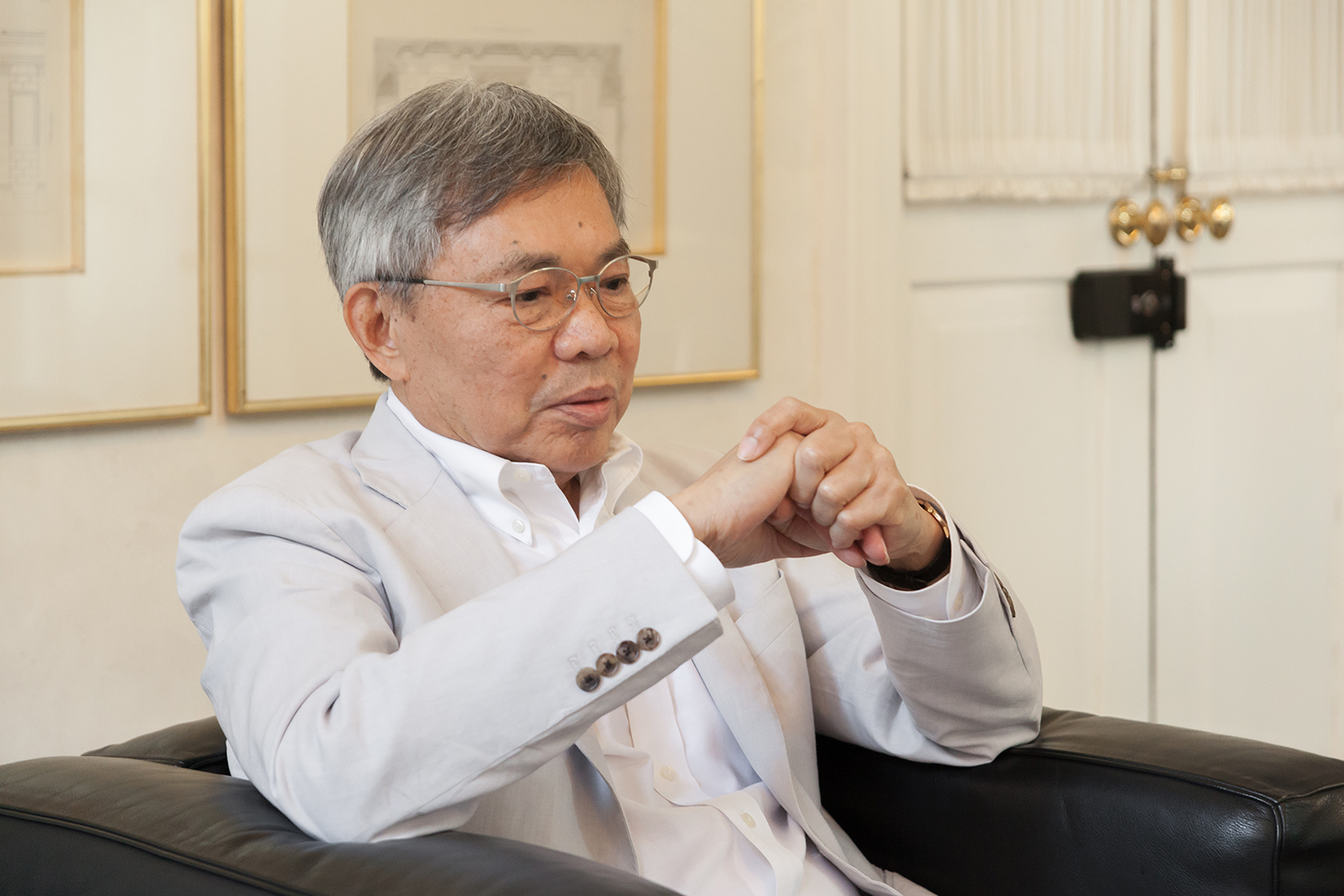
art4d: Could you go back a bit and talk about why you chose to study architecture?
Ong-ard Satrabhandhu: My family was building a home and I was always around the construction site. I think my dad noticed that and luckily made the right decision to encourage me to pursue my interests in architecture. I was fortunate that I got accepted into Cornell (Cornell University College of Architecture, Art, and Planning). The only student I knew there was Dan Wongprasat, he was one year my senior and there were only two Thai students at the times. When I first got there, I didn’t know anything. I didn’t know about the basics that most of the students who were accepted into the school knew. For example, they would know the names of the architects who were the master builders at the time but I didn’t know anything. I was pretty much struggling with the language as well, but I finally got through that. Once the school started, I did some research and gradually became more informed about things, and it was then that I began to really like and become impressed with architecture.
art4d: Who were you studying with at Cornell?
OS: There was Colin Rowe who was teaching History and Theory of Architecture. I got to be a student in one of his history courses in the third year. What people reference from Rowe’s coursework is the idea of the mathematics of ideal villas (The Mathematics of the Ideal Villa and Other Essays). What he was teaching made history interesting because he compared it to the present and he showed us that history is something you just can’t disconnect from but in the meantime, we didn’t know how the stuff he was teaching us could be applied. He made intriguing comparative observations between Palladio and Le Corbusier’s works but none of us were able to utilize that. He taught us that good architecture needed to be clear, simple, balanced, serene and proportionally harmonized. When I was studying at Yale (Yale School of Architecture), James Sterling who was becoming this sensational figure, was one of the professors and I remember feeling so amped, but I didn’t know back then that Sterling’s works that I liked actually had Léon Krier as a major back office. Krier is the person who wrote the introduction for my book and Sterling didn’t mention him at all. The truth of the matter is it’s very difficult to pull off vernacular, traditional or classical work but I’ve heard people talk so much about it. Especially in Siam, people always say that there wasn’t any creativity behind these works and that they were all copies and easy, but the truth is that this is because they never tried working with traditional tropical architecture before. If they would try, they would realize that without an understanding of traditional and classical languages it’s like you are speaking a language and your grammar is off.
art4d: Apart from Colin Rowe, James Sterling and Léon Krier, which architects would you say influence the way you view architecture?
OS: When I was a student, Le Corbusier was definitely one of the master builders. There was also Alvar Aalto and Frank Lloyd Wright, but I didn’t really get into Mies van der Rohe even though I’m very impressed by his intricateness and simplicity.
art4d: What was your thesis at Cornell about?
OS: The masterplan of Panabhandhu School with an emphasis on designing the space.
art4d: What did you do after Yale, did you open your office right away?
OS: After graduation, I worked in the States for about two years, first in New Haven and then I moved to Glen Paulsen (Glen Paulsen & Associates Architects) in Bloomfield Hills. At the interview, I told them that I wasn’t really good at working drawings so I was working on the design. I ended up doing a few projects there. I was happy with the work and planned to continue to stay there but my mother was very witty. She told me that she had two projects waiting for me at home, one was Panabhandhu School, and there was another building at Kasetsart University, so I went home otherwise I would have stayed there.
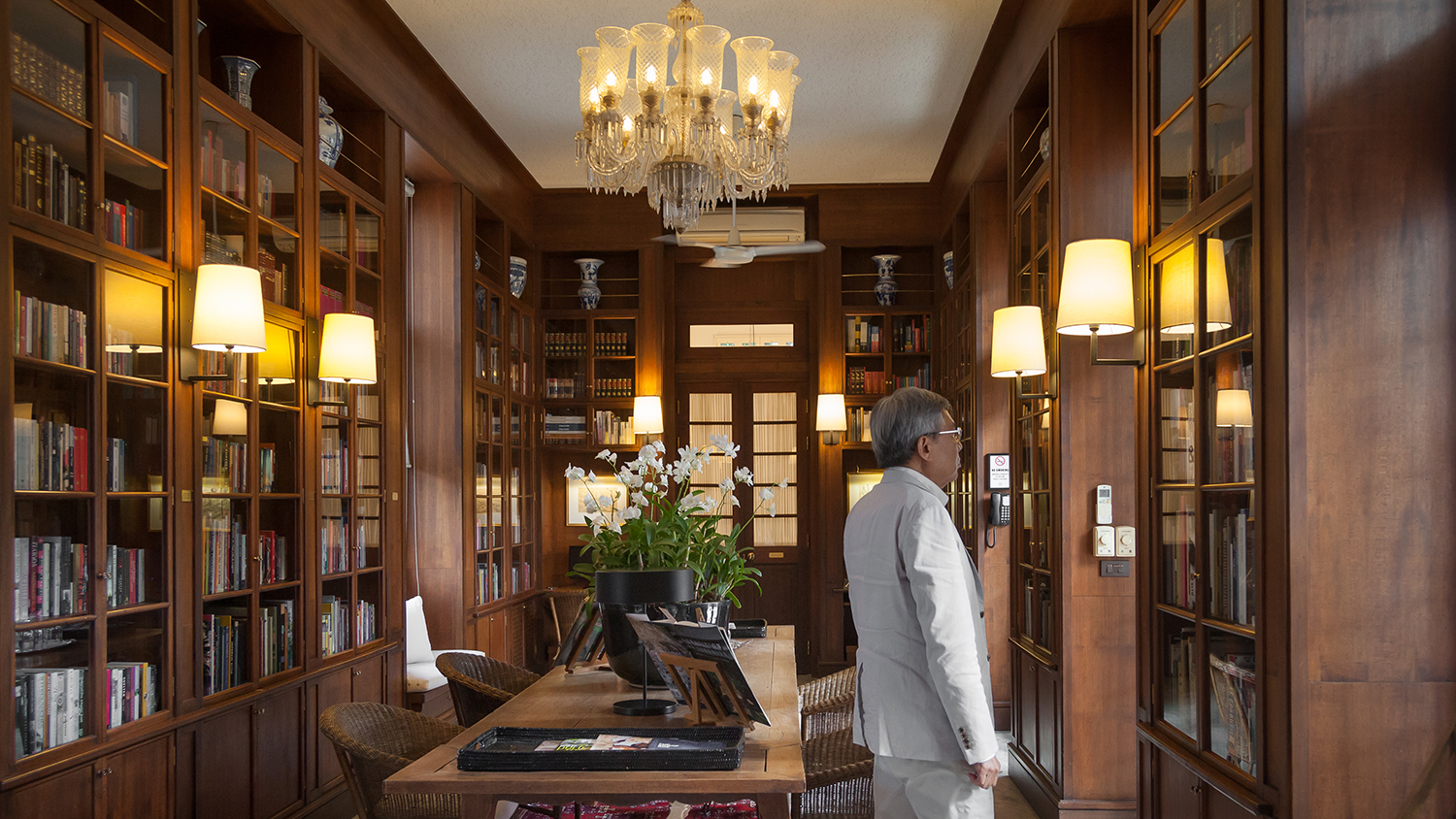
art4d: What made you decide that the two works were going to be Corbusian architecture?
OS: I wasn’t that experienced back then and thought that exposed concrete should be something that would suit Thailand while Thai builders were very skilled with formwork and the labor costs were cheap. The idea of not painting the building seemed like a good idea and I’ve always loved Corbusier’s works because the forms are very appealing. I didn’t think about the comfort of the people who use the building, or if people would like it at the time. I didn’t think much about these things. It was a very abstract way of thinking, very childish. I think it would be the same with the way kids these days prioritize attractiveness, but concrete’s thermal mass is quite high and it affects people inside so it isn’t ideal for a building in a tropical country such as Thailand.
art4d: Did you reference the structural proportion of the buildings to Le Modulor or any particular principle?
OS: I didn’t use Le Modulor but I did try to explore the Renaissance’s golden triangle and compositions of other systems that Colin Rowe talked about. For instance, every element needs to be proportionally harmonized. If you study some good examples of architecture throughout history, you will notice that they are all of a good proportion because those buildings stick to the principles of the golden triangle and squares. Andrea Palladio, the father of American Architecture, once wrote about the language of classical architecture and the importance of proportions in his treatise ‘The Four Books of Architecture.’
I like Le Corbusier because his works impress me and I’ve seen almost all of his buildings in Europe. I went to Chandigarh when it was first completed. The group of buildings has a beautiful form and the movement is great. The Architectural Promenade plays a big and important role in his works.
art4d: Would you say that ‘proportion’ is the essence of every work that you have done?
OS: What’s also important apart from proportion and what has always been something I think about is the movement through space. Ancient Chinese architecture also has very beautiful movement in their buildings which always contain these four principles: bilateral symmetry, axiality, hierarchy, and enclosure. I think we should, in some ways, utilize these principles. Mies van der Rohe designed a home that had the exact elements of a Chinese home. He was very interested in Chinese philosophy and one of his friends taught Chinese philosophy in college. Not only should we acknowledge the importance of these things, but also the history of architecture. It’s something we cannot be unaware of.
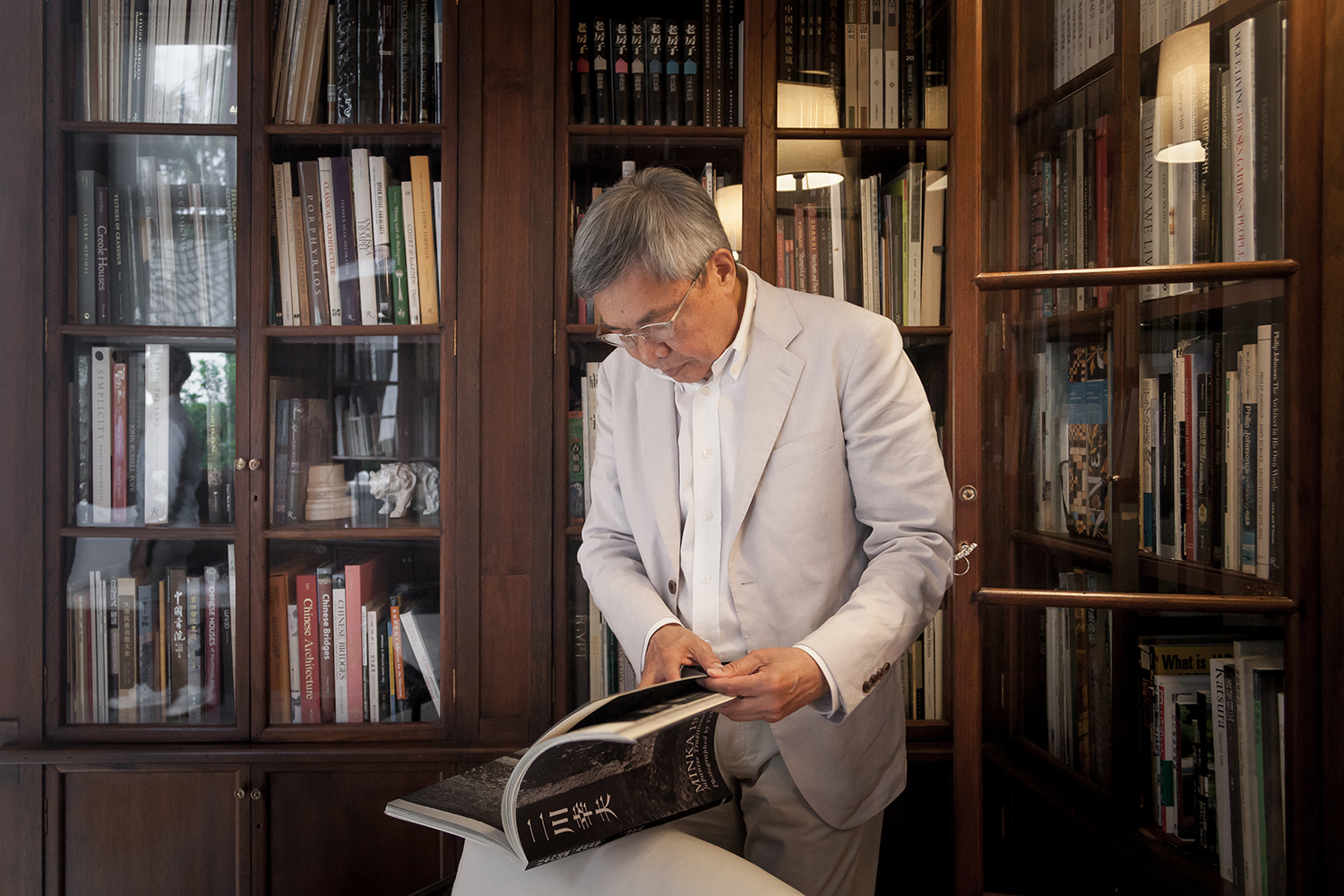
art4d: History of architecture seems like the kind of subject that most architectural students take for granted despite the fact that history plays a significant role in architectural creation. What’s important about history in your view?
OS: I think if we teach the history of architecture using beautiful villas as case studies, the students will probably like it. Don’t put too much emphasis on the year in which a certain building was constructed or who designed it, but rather the reasons why a built structure is great. Villa Lante in one of Rome’s suburbs is a very beautiful work of Mannerist architecture. The villa and its garden harmonize with the surrounding hill and it has this movement through space that is quite impressive. It’s hard to explain it in words. You have to see it with your own eyes. What differentiates architects at present from those in ancient times is their construction expertise. My weak point is that I can’t actually do the actual construction. You should be able to saw the wood and hammer a nail because you’ll get a good feeling from it. At Yale, when Charles Moore was the Dean, he had this idea for students to come up with a project and actually build it for a community. It was such a great initiative. You have to remember that architects were not academically trained to become professional practitioners. Brunelleschi built that dome and he was no engineer, but he did think about how the structure would be constructed, and that kind of process allows for one to really understand the core of it. At the beginning of my practice back then, we still had this type of craftsmen/builders to whom I could explain my ideas and ask them how to build such things.
art4d: Were the standards of contractors so much different back then as compared to today?
OS: There are no standards at all these days. There used to be builders that I could consult with but today contractors ask me what I want them to do. I don’t know, and that’s why I ask. It’s sad. Palladio was a mason and someone noticed his skills so they trained him and made him a great builder, but contractors today do their job for the money. It’s a business and they’re investors. They find people to do the work, to lay the bricks, cut the wood and so on. It becomes just a job that they have to finish in order to get paid, not because they want to create something. The builders I knew and worked with back in the 70s were very proud of what they did. You don’t get that nowadays. A contractor that really impressed me and is someone I have great respect for is Shun Chatroopsevi. He was a person who could better my works and I have worked with him since the Panabhandhu School project as well as the one at Kasetsart University. He was my first choice in all the projects that I have done. He passed away and his sons took over, and I worked with them, but they aren’t in the business anymore because there isn’t that much money in doing the kind of work that they do in the way that they used to do it. One of his sons is selling noodles for a living now. I’m not joking. He said the money is better and he doesn’t have to work as hard.
art4d: Which engineers did you work with in the past?
OS: I used to work with Professor Arun (Professor Emeritus Arun Chaiseri), but after I moved to Chiang Mai, I worked with the engineers who were based here instead. Speaking more about contractors, the headquarters of Toshiba (Thailand) had very skilled in-house bricklayers and it was this condition that led to the completion of the building.
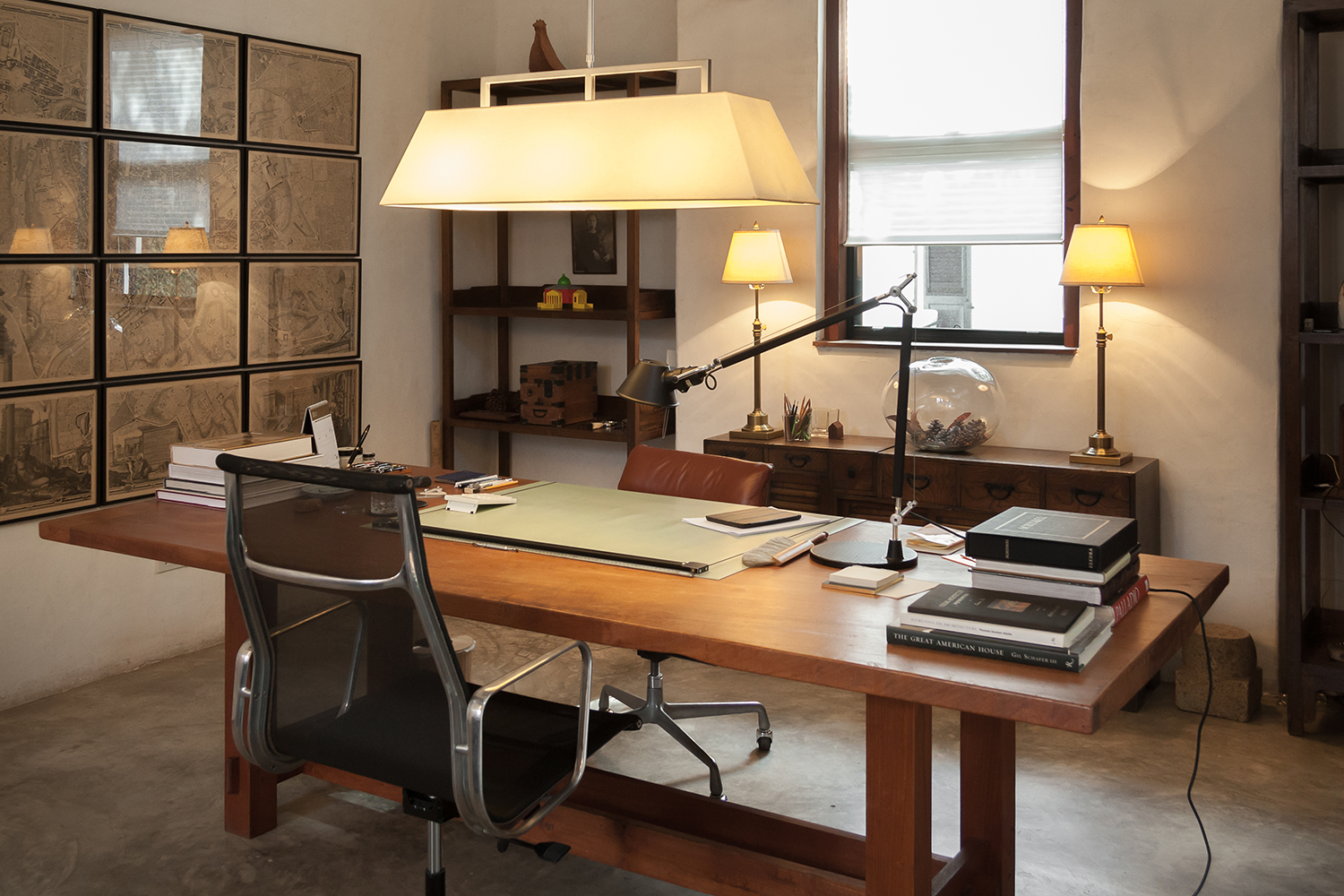
art4d: Apart from contractors, do you think architects nowadays are less concerned with intricateness because everybody is working within such a limited deadline?
OS: Maybe. I think clients are more demanding about the timeframe as well. There have been many projects that I haven’t been able to do because they have had such a limited timeframe. I did try to tell them that the shorter the time, the better it is for me because it means that I’ll get paid faster but it’s not good for the work. Some of the buildings in Bangkok have glass elevators that you can see through and you notice that the details are off. If we look at buildings nowadays, we can see that they really lack intricateness.
art4d: When you are presenting your ideas to clients, what are your methods of communication that allow for them to understand what you’re trying to propose? You don’t use computers much as far as we know.
OS: I usually use models. I make my own models and, at times, supervise them if I have someone else making them. I’m definite about what I want to emphasize, which is the movement through space. I communicate with them in a way that sections or whatever aren’t really that important. It’s like when you see a poster. If it’s a high rise building it’s like looking at a poster from a bird’s-eye view. We may have to stop and think for a moment and consider that what they’re presenting isn’t the real thing but it is what we are trying to achieve. I do provide additional explanations regarding what a building will eventually look like when it’s finished and I often present them with what I think is beautiful. What’s sad is that most of the things I show are not in Thailand. I put together the things that I think are beautiful. I think it’s okay to use the word beautiful because, at the end of the day, the question is do we ultimately try to create a beautiful creation so that it won’t end up a massive piece of trash? So with the contemporary concept that talks about how architecture has to reflect the society it is in, these buildings and the urban fabric that seem so chaotic are because our society is such chaos. Shouldn’t we built it more peaceful?

